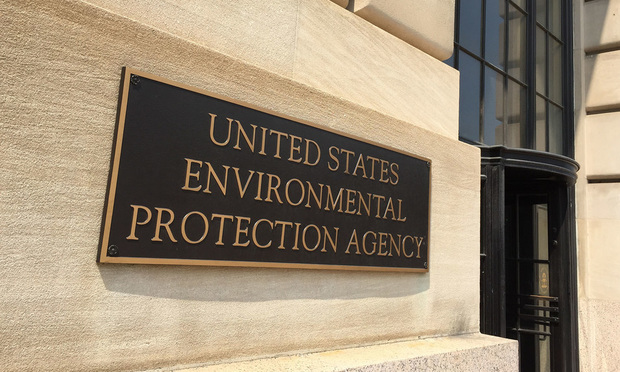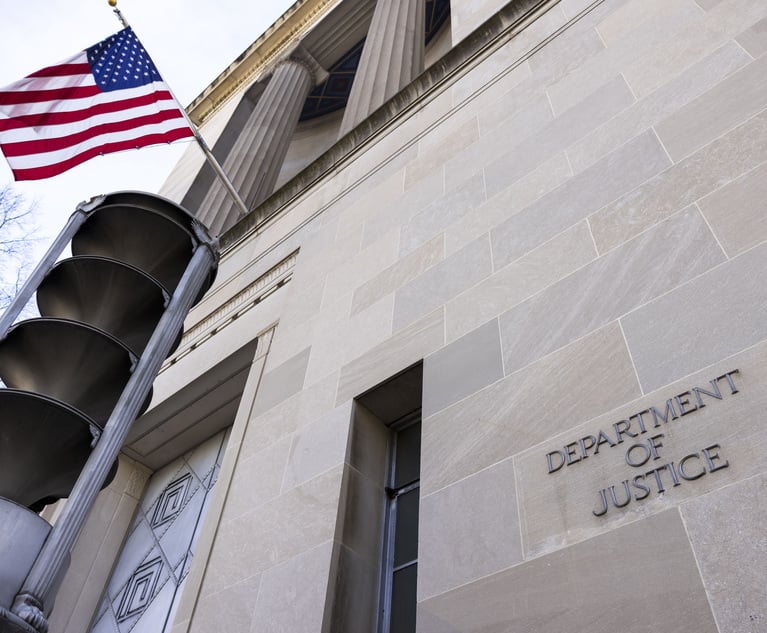New York Leads Suit Against EPA Over Decision Not to Curb Interstate Smog Pollution
State officials had been seeking to compel the federal agency to identify emissions from approximately 350 sources in nine states to the south and west of New York as a contributing factor to unhealthy air quality for several residents.
October 29, 2019 at 05:49 PM
5 minute read
 (Photo: Diego M. Radzinschi/ALM)
(Photo: Diego M. Radzinschi/ALM)
Attorneys for New York state are asking a federal appellate court in Washington, D.C., to invalidate a decision by the Trump administration that declined to identify hundreds of sources of emissions as a contributing factor to smog pollution in New York.
That decision, from the U.S. Environmental Protection Agency, will allow the federal government to forego placing restrictions on those emissions to comply with the Clean Air Act.
State officials had been seeking to compel the federal agency to identify emissions from approximately 350 sources in nine states to the south and west of New York as a contributing factor to unhealthy air quality for several residents.
New York Attorney General Letitia James said more than two-thirds of New York's population, from the New York City metropolitan area and Chautauqua County in western New York state, experience unhealthy air quality.
"More than two-thirds of New Yorkers regularly breathe unhealthy air due to interstate smog pollution, yet the EPA continues to ignore the Clean Air Act," James said. "We will not remain idle when a federal agency called the 'Environmental Protection Agency' routinely refuses to protect the environment or the health of millions of people."
Georgia Pestana, the acting corporation counsel for New York City, and New Jersey Attorney General Gurbir Grewal also signed onto the lawsuit with New York state.
A spokeswoman for the EPA said the agency doesn't comment on pending litigation.
Nine counties in New York are currently considered by the EPA to be out of compliance with federal health standards for smog, according to the Attorney General's Office. Officials from New York state have largely attributed that to pollution from other states.
That's because New York, according to the Attorney General's Office, has some of the strictest air quality regulations in the country. Emissions of pollutants that cause smog are aggressively regulated, which has led to some of the lowest emissions of those toxins nationwide.
Those pollutants, when emitted, can travel hundreds of miles from their source, according to the Attorney General's Office. That means that states upwind of New York, like Illinois and Virginia, can cause higher smog pollution downwind.
The federal Clean Air Act's "Good Neighbor" provision allows the EPA to step in and create plans to curb pollution in downwind states when the actions of upwind states aren't enough to reduce smog elsewhere. That's where New York's petition to the EPA earlier this year comes in.
New York was seeking to have the EPA recognize that emission sources in the nine states it identified were significantly contributing to the state's smog problems. That way, under the Clean Air Act, the federal government could step in and help curb those emissions.
The EPA, in its decision, said it couldn't find evidence, nor was it provided with information, to show that those emission sources were directly causing New York's smog problem.
"The EPA is denying the petition because the petitioner, New York, has not demonstrated, and the EPA did not independently find, that the group of identified sources emits or would emit in violation of the good neighbor provision," the EPA said.
The two-page lawsuit brought against the agency by James on Tuesday is essentially seeking to strike down that finding. The challenge was filed in the U.S. Court of Appeals for the D.C. Circuit.
It's not the first time New York state has brought litigation against the EPA over interstate smog.
James, leading a coalition of six states and New York City, sued the federal agency in January over a proposed rule that would have allowed states to avoid taking any additional action to curb interstate smog. That rule was vacated by the D.C. Circuit.
New York state also challenged the EPA's alleged failure to intervene in the planned emission reduction plans of states that were identified in 2015 as not doing enough to curb interstate pollution.
The decision, handed down in the Southern District of New York, ordered the EPA to address emission levels in states whose pollution traveled into New York. There was no appeal.
READ MORE:
NY AG James Leads Coalition in Interstate Smog Lawsuit Against US EPA
Eight States Sue US Environmental Protection Agency Over Upwind Air Pollution
NY State Claims EPA Acted Outside Its Authority in Lawsuit Against Hudson River Cleanup Decision
This content has been archived. It is available through our partners, LexisNexis® and Bloomberg Law.
To view this content, please continue to their sites.
Not a Lexis Subscriber?
Subscribe Now
Not a Bloomberg Law Subscriber?
Subscribe Now
NOT FOR REPRINT
© 2025 ALM Global, LLC, All Rights Reserved. Request academic re-use from www.copyright.com. All other uses, submit a request to [email protected]. For more information visit Asset & Logo Licensing.
You Might Like
View All
'A Shock to the System’: Some Government Attorneys Are Forced Out, While Others Weigh Job Options
7 minute read

Trending Stories
- 1Munger, Gibson Dunn Billed $63 Million to Snap in 2024
- 2January Petitions Press High Court on Guns, Birth Certificate Sex Classifications
- 3'A Waste of Your Time': Practice Tips From Judges in the Oakland Federal Courthouse
- 4Judge Extends Tom Girardi's Time in Prison Medical Facility to Feb. 20
- 5Supreme Court Denies Trump's Request to Pause Pending Environmental Cases
Who Got The Work
J. Brugh Lower of Gibbons has entered an appearance for industrial equipment supplier Devco Corporation in a pending trademark infringement lawsuit. The suit, accusing the defendant of selling knock-off Graco products, was filed Dec. 18 in New Jersey District Court by Rivkin Radler on behalf of Graco Inc. and Graco Minnesota. The case, assigned to U.S. District Judge Zahid N. Quraishi, is 3:24-cv-11294, Graco Inc. et al v. Devco Corporation.
Who Got The Work
Rebecca Maller-Stein and Kent A. Yalowitz of Arnold & Porter Kaye Scholer have entered their appearances for Hanaco Venture Capital and its executives, Lior Prosor and David Frankel, in a pending securities lawsuit. The action, filed on Dec. 24 in New York Southern District Court by Zell, Aron & Co. on behalf of Goldeneye Advisors, accuses the defendants of negligently and fraudulently managing the plaintiff's $1 million investment. The case, assigned to U.S. District Judge Vernon S. Broderick, is 1:24-cv-09918, Goldeneye Advisors, LLC v. Hanaco Venture Capital, Ltd. et al.
Who Got The Work
Attorneys from A&O Shearman has stepped in as defense counsel for Toronto-Dominion Bank and other defendants in a pending securities class action. The suit, filed Dec. 11 in New York Southern District Court by Bleichmar Fonti & Auld, accuses the defendants of concealing the bank's 'pervasive' deficiencies in regards to its compliance with the Bank Secrecy Act and the quality of its anti-money laundering controls. The case, assigned to U.S. District Judge Arun Subramanian, is 1:24-cv-09445, Gonzalez v. The Toronto-Dominion Bank et al.
Who Got The Work
Crown Castle International, a Pennsylvania company providing shared communications infrastructure, has turned to Luke D. Wolf of Gordon Rees Scully Mansukhani to fend off a pending breach-of-contract lawsuit. The court action, filed Nov. 25 in Michigan Eastern District Court by Hooper Hathaway PC on behalf of The Town Residences LLC, accuses Crown Castle of failing to transfer approximately $30,000 in utility payments from T-Mobile in breach of a roof-top lease and assignment agreement. The case, assigned to U.S. District Judge Susan K. Declercq, is 2:24-cv-13131, The Town Residences LLC v. T-Mobile US, Inc. et al.
Who Got The Work
Wilfred P. Coronato and Daniel M. Schwartz of McCarter & English have stepped in as defense counsel to Electrolux Home Products Inc. in a pending product liability lawsuit. The court action, filed Nov. 26 in New York Eastern District Court by Poulos Lopiccolo PC and Nagel Rice LLP on behalf of David Stern, alleges that the defendant's refrigerators’ drawers and shelving repeatedly break and fall apart within months after purchase. The case, assigned to U.S. District Judge Joan M. Azrack, is 2:24-cv-08204, Stern v. Electrolux Home Products, Inc.
Featured Firms
Law Offices of Gary Martin Hays & Associates, P.C.
(470) 294-1674
Law Offices of Mark E. Salomone
(857) 444-6468
Smith & Hassler
(713) 739-1250







